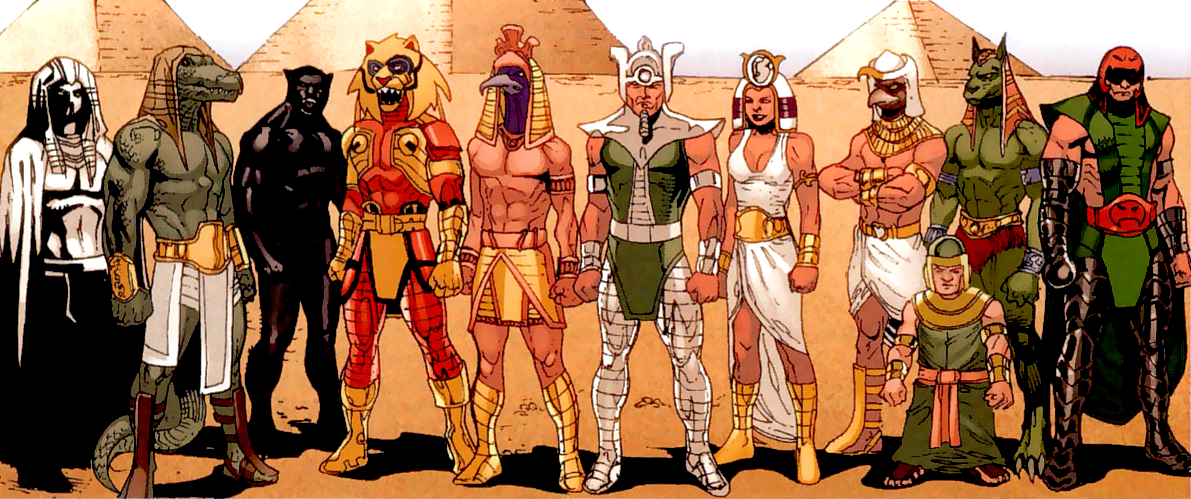Heliopolitans: Egyption Gods

| Character Name | Ideals |
|---|---|
| Geb | God of Earth |
| Horus | God of the Sky |
| Isis | Goddess of Magic & Medicine |
| Nut | Goddess of the Sky |
| Osiris | God of the Dead |
| Seth | God of Chaos |
History
Heliopolis, a Greek word meaning "City of the Sun", is now a part of the modern city of Cairo, but in the time of Ancient Egypt it was once of the four major centers of worship for the ancient Egyptian religion (The other three cities were Hermopolis, Memphis, and Busiris). The gods worshipped at Heliopolis became the most widely known and honored in all of Egypt, and constitute one of Earth's first great pantheons. The gods of Heliopolis were said to have originated on Earth and actually dwelled in Heliopolis until the time that the human pharaohs took over the rule of the earthly kingdoms. At that time, the pantheon founded its own celestial city of Heliopolis in a dimension adjacent to Earth's. It is there that the gods of ancient Egypt have dwelled through historical times till the present. Very little is known about the celestial Heliopolis other than it appears to be built on a small planetary object much like the realm of the Norse gods, Asgard, is, and its passage to earth is a golden bridge through space called the Path of the Gods, which is analogous to the Asgardians' Rainbow Bridge.
The gods of Heliopolis came into existence over several generations, even as the Olympian gods derived from the older generation of Titans. Before there were any other gods there wa Nun, the essence of chaos or the primordial ocean of nothingness. Nun was said to sire Atum, the first physically manifested god among the Heliopolitans (and possibly other pantheons as well). Atum later took the aspect and identity of Ra, the primordial god of the sun and first god to develop a cult of worshipers among the Egyptians. Ra was said to sire the next generation of gods, Shu and Tefnut, without a female mate. Shu took Ra's place when Ra became too weary and old to rule, and became the god of air. His twin sister Tefnut ruled at his side as goddess of the rain. Shu and Tefnut begat the fourth generation of gods, Geb and Nut. Geb was a god of the earth, having a natural affinity for mountains and other parts of the earth's crust. Nut was a goddess of the sky, specifically the starry heavens.
Geb and Nut succeeded their parents when they too became too infirm to rule, and begat the next more numerous generation of gods, eldest among which was Osiris. Osiris's sibling included Isis, whom he took as a wife, Seth, and Nepthys. Osiris became the head of the pantheon when Geb stepped down, and is credited with the spread of civilization throughout Egypt and beyond. Osiris was the last ruler of Egypt before historical times and the human pharaohs came to rule. Osiris became the benevolent god of the dead, preparing the afterlife for his loyal worshippers. Osiris's wife Isis was believed to teach humanity, the arts of medicine and the principles of domestication. She was also a powerful sorceress who was able to bring Osiris back to life after he had been murdered and dismembered by his jealous younger brother Seth. Seth was the god of evil and destruction, who sought to rule Heliopolis himself, and murdered Osiris in order to do so. his wife Mephthus, daughter of Geb and sister of Isis, was also a goddess of the dead but was not evil like her husband. Nephthus had no offspring with Seth, but bore Osiris a son, Anubis.
Anubis invented funeral rites and mummy wrappings, and although it was Isis' magic that rose Osiris from the dead, her magic would have been useless had Anubis not specially prepared Osiris' body. Osiris and Isis had a son, Horus the god of the sun. Horus was also instrumental in helping raise his father from the dead after Seth's treachery. Upon resurrection, Osiris dispatched his son Horus to find Seth to make him pay for his treachery. Eventually Horus encountered Seth and their cataclysmic clash lasted centuries. Seth finally got the upper hand over his nephew and Seth used his power to seal Horus, Isis, and Osiris within a pyramid on Earth. There they remained until the Twentieth Century when Odin, then lord of the gods of Asgard, assumed the guise of Atum-Re, an aspect of the first of the gods, in order to free them. Odin's son Thor aided the Heliopolitans in vanquishing Seth.
While Osiris, Isis, and Horus were imprisoned, the moon god Thoth, who had served as Osiris's grand vizier, became head of the Heliopolitan pantheon. Thoth was believed to be a later son of Nun, the primordial chaos, which would make him a brother to Atum. Still, he came along much later than Atum and appears to be a contemporary of Osiris. After each generation of Heliopolitan gods retired from earthly rule, they traveled to the dimension of the celestial Heliopolis to live out eternity. Beginning with the rule of Thoth, however, all of the gods moved to the otherdimensional realm, to traffic with the Earth no more. When Osiris returned,d Thoth gave up the throne to his mentor. The gods of Heliopolis have remained in the extradimensional realm since, having little traffic with Earth. Like most races of gods, they are believed to be mere figments of myth by most of humanity.